Bernedoodles come in a range of different coat types. It’s important to know the coat differences and how to care for them so you can understand the grooming needs of your Bernedoodle. So in this article, we identify the different Bernedoodle coat types and what’s required to look after them.

Bernedoodles come in three different coat types; curly, wavy and straight. While curly and wavy coats require more grooming, they are low to non-shedding. On the other hand, straight coats will shed more hair but require less grooming.
Let’s find out more details about each Bernedoodle coat type and how to care for them.
Related: Bernedoodle Temperament Guide | Bernedoodle Color Guide | 10 Bernedoodle Health Problems To Know Before Buying | Bernedoodle Size and Weight Guide
Curly Coat Bernedoodle
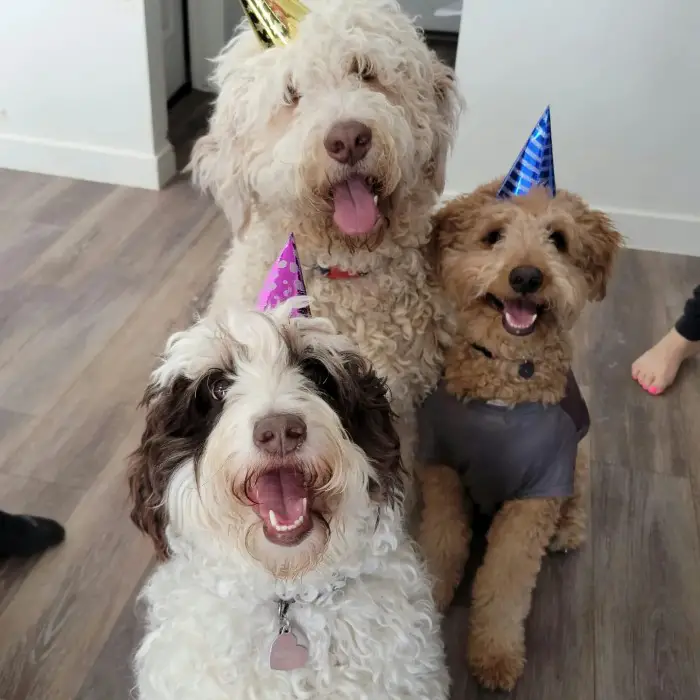
Bernedoodles with a curly coat take after their Poodle parent. The appearance of the curly coat is tightly curled, forming ringlets or spirals. Curly coats are also known as wool coats and are typically a single coat.
Bernedoodles with curly coats are generally considered hypoallergenic and tend to be non-shedding. This makes curly-coat Bernedoodles a great option for those with allergies.
However, curly coats require more frequent grooming to prevent matting and it is considered high maintenance due to the regular grooming required.
Bernedoodle Curly Coat Care Requirements
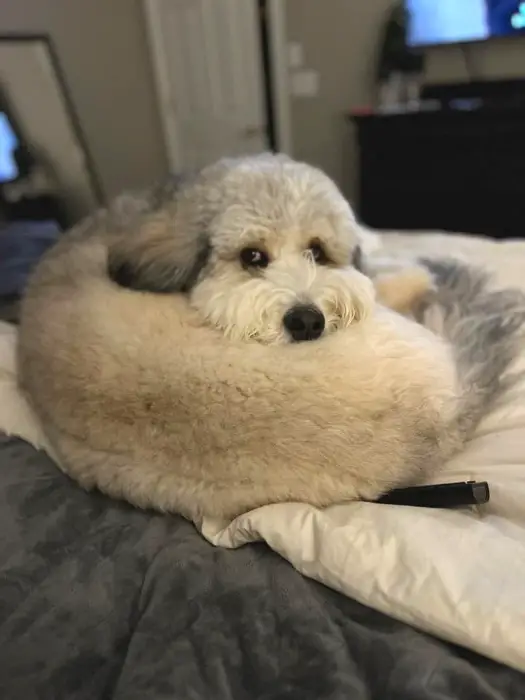
Maintaining a Bernedoodle with a curly coat requires specific care to keep its appearance and coat health in top condition.
While curly coats don’t shed much, they are prone to matting and trapping dirt in the coat.
Regular brushing is essential, ideally daily or every other day, to prevent tangles. A slicker brush or pin brush is a great option. Brushing is a great way to bond with your dog, so take the time to enjoy the experience and start when your Bernedoodle is a pup.
Professional grooming is recommended every 6-8 weeks. Groomers can trim and shape the curly coat to maintain its appearance and manage any matting. You should factor in the cost associated with grooming as it’s not cheap but it is worth it and potentially necessary if you are not doing your own grooming. While you can undertake your own grooming, due to the commitment to learning how to along with the cost of the tools, many owners decide to go with professional grooming.
You can bathe your curly coat Bernedoodle as needed, typically every 6-8 weeks. Use a quality dog shampoo and conditioner. I like to use a gentle oatmeal shampoo and conditioner to help protect my dog’s skin.
Wavy Coat Bernedoodle
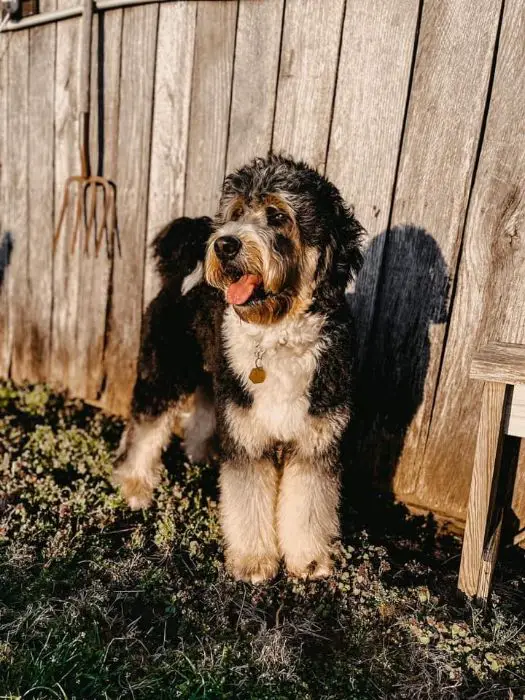
Bernedoodle wavy coats have a beautiful, gently wavy texture. Wavy coats are a blend of both parent breeds (the Poodle and Bernese Mountain Dog) and are often low to non-shedding. Wavy coats are also known as fleece coats and exhibit loose, gentle waves throughout their fur. These waves are less tightly curled than the curly coat but not as straight as the straight coat.
Wavy coats typically shed less than the straight coat but may require similar care to the curly coat. Depending on inherited genetics, they may or may not have an undercoat.
They require regular grooming to maintain their appearance and prevent matting. Regular brushing is essential to keep these coats healthy and in good condition.
Bernedoodle Wavy Coat Care Requirements
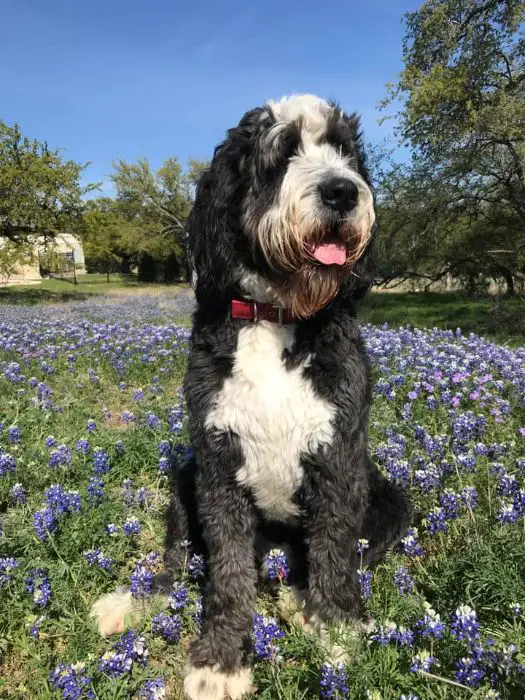
Proper care is important to maintain the appearance and health of Bernedoodle wavy coats.
Wavy coats should be brushed regularly to prevent matting and tangles. A slicker brush or pin brush is suitable. Aim to brush every few days. It’s a good idea to start brushing your Bernedoodle puppy once you bring him home to help get him used to being brushed. Once your Bernedoodle is familiar with brushing, you will both enjoy the experience together.
Like the curly coat, wavy coat Bernedoodles can be bathed as needed, generally every 6-8 weeks. Always use a dog shampoo and never a human one. They have different hair and skin and may develop a reaction to human hair products.
Professional grooming every 6-8 weeks is recommended to maintain the coat’s appearance and manage its length.
Straight Coat Bernedoodle
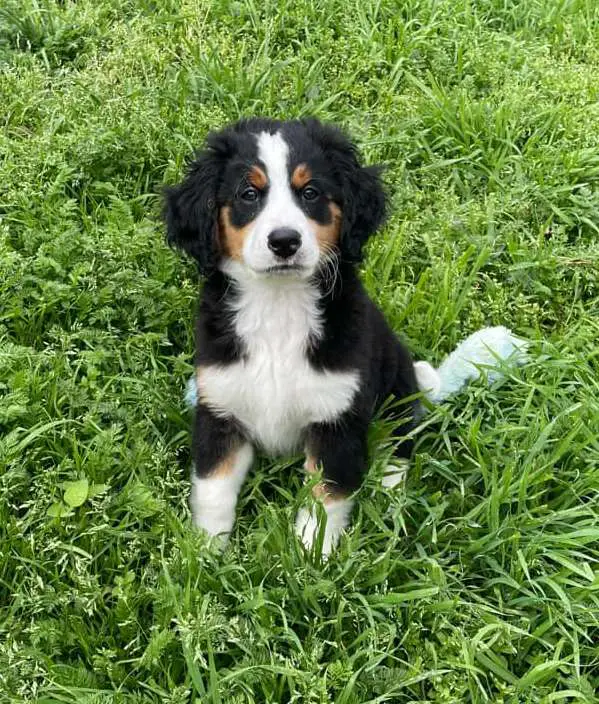
Some Bernedoodles inherit the straighter coat of Bernese Mountain Dogs. Straight coats are generally lower maintenance in terms of grooming. Though, they usually come with the shedding double coat of the Bernese Mountain Dog.
The appearance of a straight coat is sleek and flat. Unlike Beneredoodles with curly or wavy coats, they don’t exhibit waves or curls. The fur lies close to the body, creating a smooth appearance.
Straight coats still require semi-regular brushing to prevent matting. This coat type is ideal for those who want a fluffy but lower-maintenance coat.
Bernedoodle Straight Coat Care Requirements
Although the straight coat is less maintenance than the curly or wavy coats, proper care is still important to maintain the appearance and health of Bernedoodle straight coats.
Regular brushing is still necessary to remove loose hair and distribute natural oils. A pin brush or slicker brush works well for this coat type. You can aim to brush your straight-coat Bernedoodle once or twice a week.
Straight coats can be bathed every 6-8 weeks or as needed, like the curly and wavy coats.
Professional grooming is not required for straight-coat Bernedoodles. However, if you like, periodic professional grooming can help keep the coat in excellent condition and to maintain its sleek appearance.
Bernedoodle Coat Changes
Bernedoodle coats can undergo changes as they age. These changes typically occur due to the transition from puppy coat to adult coat. Coats can also change color if they have inherited the Poodle fading gene.
Bernedoodle puppies often have soft, fluffy, and sometimes curly coats. However, as they grow, their coats transition to their adult coat, which can be different in texture and color. This transition usually happens between 4 to 6 months of age, although it can vary from one Bernedoodle to another.
Some Bernedoodles experience color fading as they mature. For instance, black Bernedoodles can fade into gray or silver tones, while chocolate-colored ones might lighten. This fading is due to the influence of the Poodle genes, which can result in coat changes.
How Bernedoodle Generations Affect Coat Types
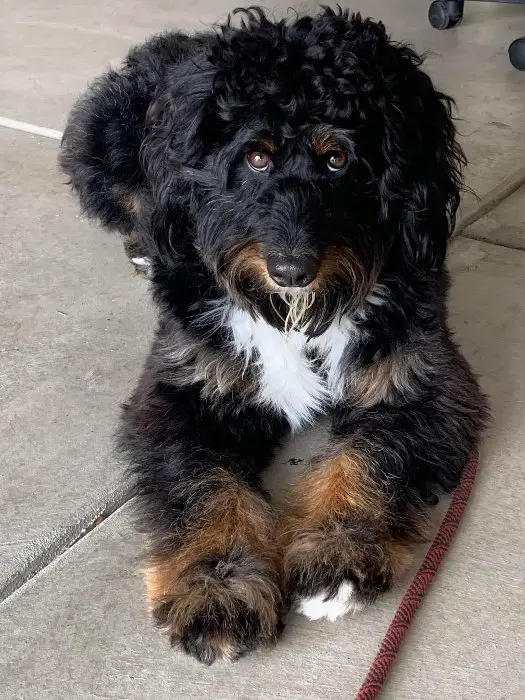
Bernedoodles come in various generations, and these generations play a key role in determining their coat types. Understanding the different generations is important for anyone considering Bernedoodle.
The F1 generation is a first-generation Bernedoodle, resulting from the direct cross between a Bernese Mountain Dog and a Poodle. Their coat type can vary widely, depending on the parents though the most common result is a wavy coat.
An F1b Bernedoodle is back-crossed usually with a Poodle to achieve a curlier coat. One parent is an F1 Bernedoodle and the other is Poodle. The F1b Bernedoodle generation typically has curlier coats, resembling the Poodle parent. By back-crossing, breeders are more accurately able to predict the coat type which in this case is sought after for those with allergies due to their low shedding coats.
The F2 Bernedoodle results from crossbreeding two F1 Bernedoodles. This generation can exhibit a variety of coat types. Including curly, wavy, or straight coats, as it depends on the specific genetics inherited.
Multigenerational Bernedoodles result from breeding Bernedoodles with other Bernedoodles over multiple generations. This generation’s coats can vary widely due to their mixed genetics.
Shedding in Bernedoodles with Double Coats
If a Bernedoodle inherits a double coat, which is more likely in a straight coat then any other, shedding patterns can vary based on the time of year and the specific dog. Shedding can occur in spring and fall.
Many double-coated Bernedoodles experience heavier shedding during the spring. This is often referred to as “blowing their coat.” As the weather warms up, they lose their winter undercoat to prepare for the summer.
Fall shedding, while typically less intense than spring shedding, can still occur. Bernedoodles may shed their summer coat to grow a thicker, insulating winter coat.
Regular brushing is especially important during shedding seasons. Brushing your Bernedoodle helps remove loose fur, prevent matting, and it promotes a healthy coat. Use a slicker brush or undercoat rake for double-coated Berendoodle dogs.
Occasional baths can help manage shedding by removing loose hair and maintaining coat health. However, avoid excessive bathing, as it can strip natural oils from the coat. Every 6-8 weeks is usually enough.
Bernedoodle Grooming Tips
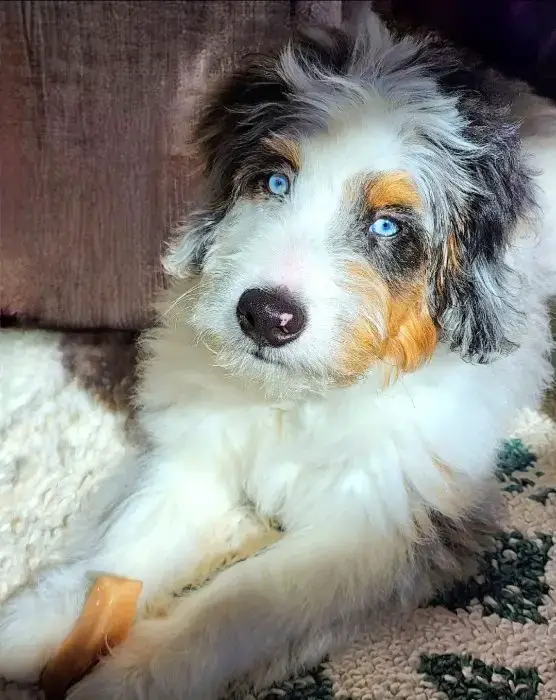
As well as looking after your Bernedoodle’s coat, you will also need to remember their ears, nails, and teeth. Some of these grooming needs can be taken care of by a groomer if you’re using one.
Regularly check your Bernedoodle’s ears for dirt, wax buildup, or signs of infection. This is especially important for floppy-eared Bernedoodles, as they are more prone to ear issues.
Clean the ears with a vet-approved ear cleaner when needed.
Trim your Bernedoodle’s nails as needed. Long nails can be uncomfortable for your dog and affect their gait. Use dog-specific nail clippers and be cautious not to cut into the quick (the sensitive part of the nail).
Regular exercise on concrete or pavement can help naturally wear down your dog’s nails, reducing the frequency of nail trimming.
Brush your Bernedoodle’s teeth regularly to prevent dental issues. Use a dog-specific toothbrush and toothpaste. Start this routine early to get your dog accustomed to it.
Dental chews or even toys can help keep your dog’s teeth clean. These can be a fun way to maintain oral hygiene.
Consider professional dental cleanings by a veterinarian when necessary. They can address tartar and plaque buildup effectively. You may not have to look into this while your dog is still young but it may be recommended as your Bernedoodle gets a bit older.
Related:
